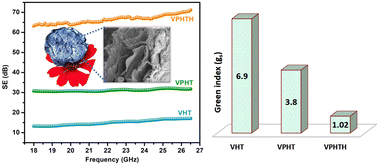Outstanding electromagnetic interference shielding performance in hydrothermally derived vanadium pentoxide–polyaniline aerogels†
Abstract
Developing green and efficient shields through facile means is one of the significant challenges in electromagnetic interference (EMI) shielding. On top of that, light materials are highly favored in portable electronics and aerospace applications due to weight reduction considerations. Herein, we synthesized V2O5 hydrogel via a simple one-pot hydrothermal route, and the nanowire network that constitutes the gel was polymerized by aniline. Aerogels obtained after freeze drying exhibit excellent shielding performance (71.2 dB), superior specific shielding efficiency (1338.8 dB cm3 g−1), and good green index (1.02). The porous structure of the materials and successful incorporation of polyaniline was confirmed by scanning electron microscopy and various spectroscopic analyses. Furthermore, V2O5–polyaniline aerogels prepared in an acidic medium have high conductivity, ample mechanical strength, and absorption dominant shielding efficiency in the entire X, Ku, and K band frequency. This paper proves that lightweight, eco-friendly aerogels with supreme shielding properties can be developed through simple and cost-effective strategies without employing carbonaceous or hazardous filler materials.



 Please wait while we load your content...
Please wait while we load your content...